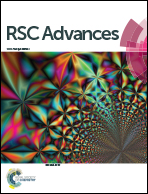Preparation of hollow PtCu nanoparticles as high-performance electrocatalysts for oxygen reduction reaction in the absence of a surfactant
Abstract
Hollow PtCu nanoparticles of about 6.9 nm supported on Vulcan XC-72 were synthesized by a facile method in the absence of a surfactant. The hollow structure was evident in TEM, HRTEM and HAADF-STEM images. The lattice contraction of specific PtCu nanoparticles was directly observed with the aid of HRTEM; furthermore, the lattice compression of the whole PtCu sample was examined by XRD. As surface sensitive measurements, XPS and CV demonstrated that the PtCu nanoparticle was covered by a Pt skin with subsurface PtCu alloy. Based on a half-cell test, the PtCu/C electrocatalysts displayed impressive ORR performance compared with the state-of-the-art Pt/C (JM). The enhanced ORR performance was attributed to the reduced adsorption strength of OHads on the surface of the PtCu nanostructures, resulting from the hollow-induced lattice compression and subsurface alloy effect. In addition, the hollow PtCu nanostructure was confirmed to be stable by two facts: (i) the hollow structure was still visible and the particle size change of PtCu was not apparent and (ii) the area-specific activity and mass activity of PtCu didn't decrease greatly after an accelerated degradation test.


 Please wait while we load your content...
Please wait while we load your content...